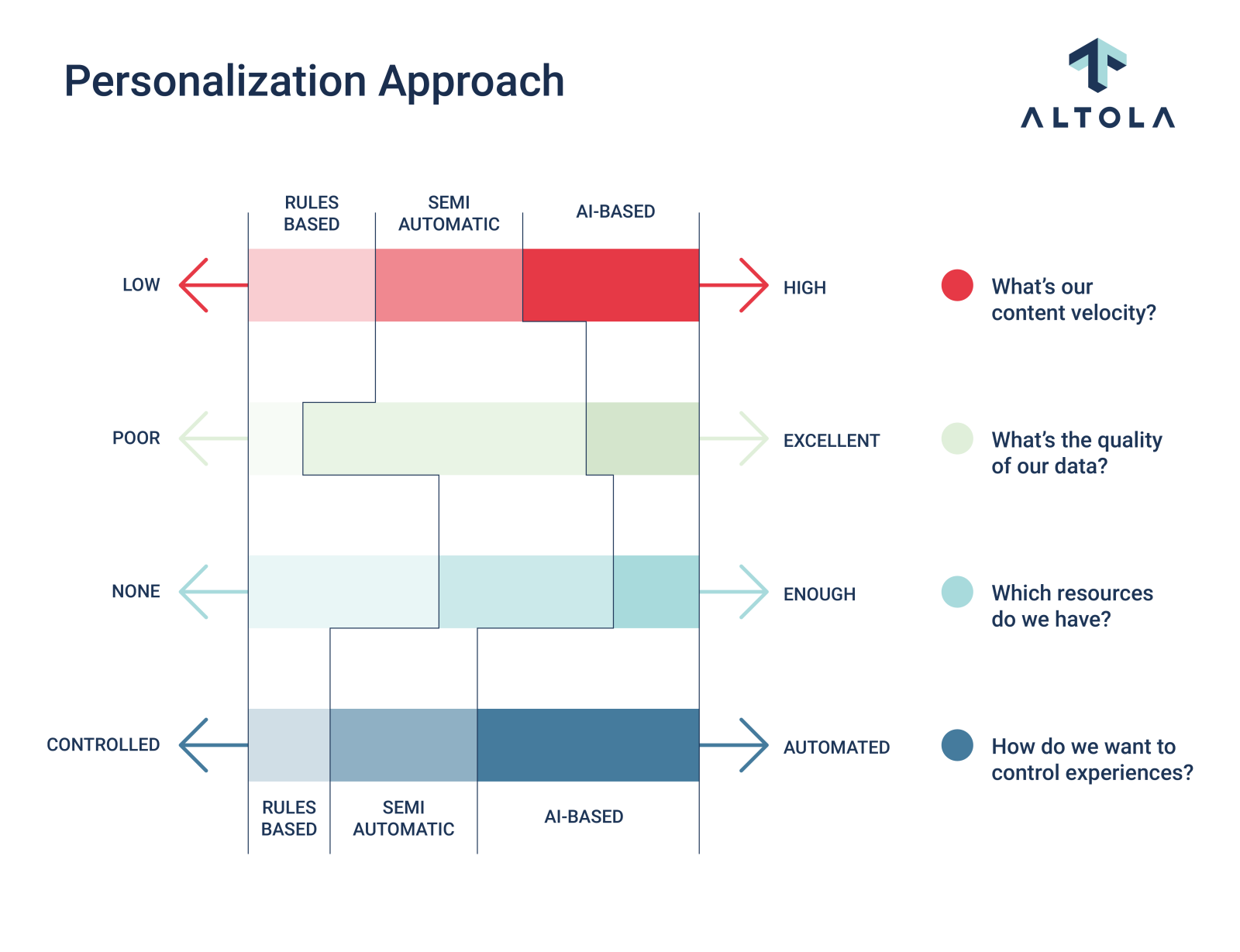The promise of fully automated, AI-based personalization is tempting, especially when marketing technology vendor demos appear to make it so easy. What you don’t see, however, is the amount of data, content and resources that are required to make fully automated personalization work.
Fully automated personalization isn’t the only option out there. In fact, it may not even be the best option for your organization. But how do you go about finding the right personalization approach?
A model that we at Altola typically use as part of our discovery sessions with a client involves answering four questions:
What’s our content velocity?
What’s the quality of our data?
Which resources do we have?
How do we want to control experiences?
Content velocity
Content is the backbone of any experience. It’s what customers actually engage with. It’s also typically THE bottleneck for doing personalization at scale. Content velocity is the rate at which your organization is able to create new content, update existing content, and support variations of content designed for a specific person, place or time.
Simple personalization, configured using rules, is less demanding in terms of content. You might start by producing 20 different calls-to-action to support personalization for big audience segments. As you scale up and create smaller, more focused segments, more content is needed. In order to support fully automated personalization, you need a lot of content.
Content velocity affects personalization for B2B and B2C organizations differently. B2B typically requires less personalized content, but a greater investment in thought leadership/content marketing programs. B2C usually requires more content, which means that greater content velocity is needed.
Things to consider are:
What’s your current speed of producing content and changes?
Do you have content embedded in marketing operations?
Does content production require a certain workflow and approval? If so, how much time does this process add to production time?
What does a realistic future-state look like in terms of content velocity?
Quality of data
The more you know about your visitor’s intent, the more relevant your personalization can be. Similarly, personalization will be less relevant when you lack quality data.
Not every organization needs to – or should – collect the same data. The end-goal should drive the data you collect: What do you want to achieve in terms of personalization? What are the great experiences you want to deliver to your visitors along their journey? What data is needed to power those experiences?
Collecting a variety of data helps to improve the quality of your data by adding some balance. There are several categories of data to consider. I describe these in detail here, but here they are again:
progression in the customer journey
in-the-moment intent
who the person is?
the situation
AI-based personalization depends on a variety of data. If the only thing your ML model knows about is page views, then the only thing personalization can be based on is a simple clickstream. Collecting data from different sources gives you a more complete understanding of your customer.
Another way to increase data quality is to align global naming conventions and taxonomies. This enables you to recognize a visitor in a select audience segment across different channels and technologies by using the same naming conventions for all marketing activities.
Your personalization strategy will be constrained by the quality of the data you have. Data requirements for rules-based personalization are minimal since you control it by hand. As you scale up personalization, more high-quality data is needed.
Resources
Organizations have been struggling with launching personalization for the last 10 years. Much of the blame is due to resources, specifically a lack thereof. Architecting, developing and launching personalization requires resources.
If the organization is less committed to personalization, then the typical approach has been to use existing resources. The issue here is that these people are already working 50 hours per week. Adding personalization as a responsibility without removing something else sets the project up for failure.
In order to successfully implement personalization, the number of available and committed resources (both internal and external) must be identified. Few and limited resources will usually limit an organization to simple rules-based personalization. A bigger investments and dedicated resources will allow more advanced and scalable personalization.
Controlling experiences
How much do you want to control the personalization experiences? Do you want to be able to specify what content is shown to whom and when it is shown? Or is it acceptable for artificial intelligence to make those decisions for you? Or maybe you want a little of both.
Using machine learning isn’t always the best option. Letting AI drive personalization may result in unexpected results. For example, images of a Japanese family may be shown to visitors from Germany. This may not be a bad thing, but it also may not be what you want.
There’s also something in between: semi-automated personalization. This involves tagging content and, based on which content a visitor views, making an educated guess as to who the visitor is and where the visitor is coming from.
Determining a personalization approach
Based on the answers to the questions above you can use the model below to help understand the best personalization approach for your organization’s current and future states. This model helps to visualize the relationship between the personalization approaches and what is required in order to be successful with each.

Our recommendation
Based on our experience with customers of many different sized and across many industries, we have found the following to be true for each personalization approach:
Rules-based personalization is great for a start, but it doesn’t scale. Just planning for rules-based personalization will require a lot of effort as you try to scale personalization, which would end up being unmanageable.
Semi-automated personalization can come in many shapes. It gives the brand a good opportunity to start with personalization that is built to scale and can support needs of the business.
Automated (AI-or-ML based) personalization is great for ambitious brands who have resources and investment to use AI to scale personalization. However, this approach requires data that is almost never available at the start of a project, making it very unlikely that a brand can jump into automated personalization without first having done some rules-based or semi-automatic personalization.
Reach out if you have any comments or would like to know more about how Altola can help your organization identifying the right approach to personalization.
